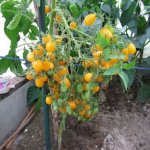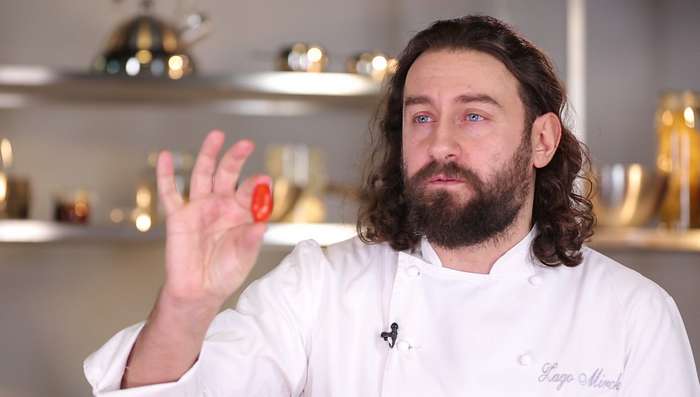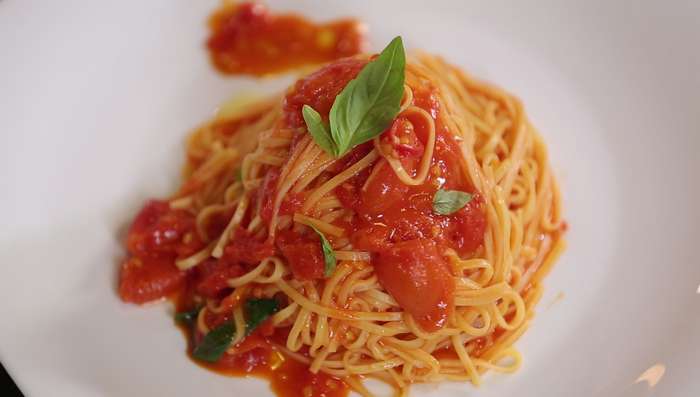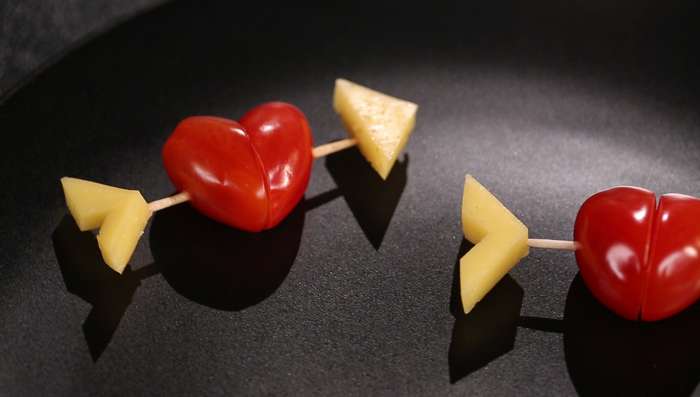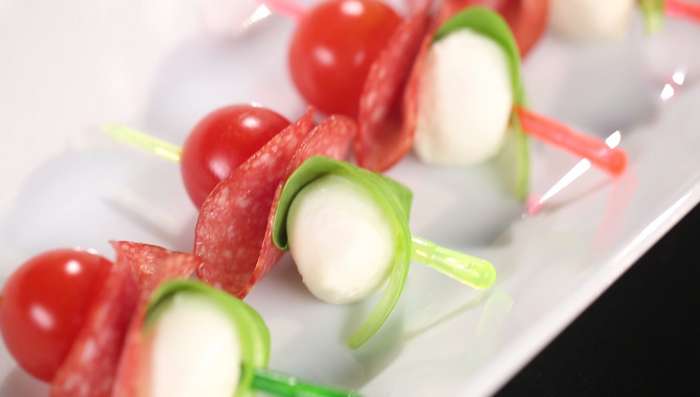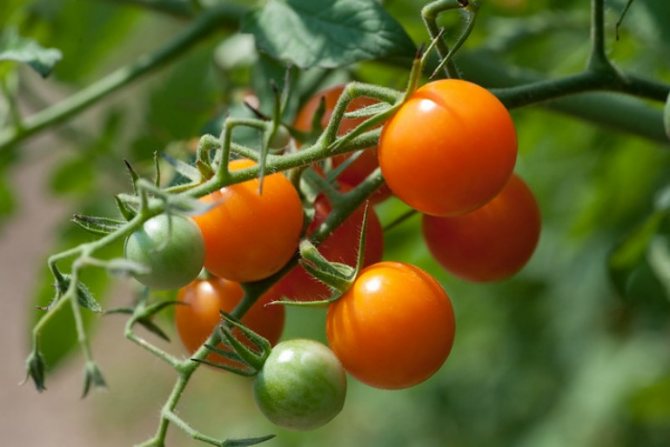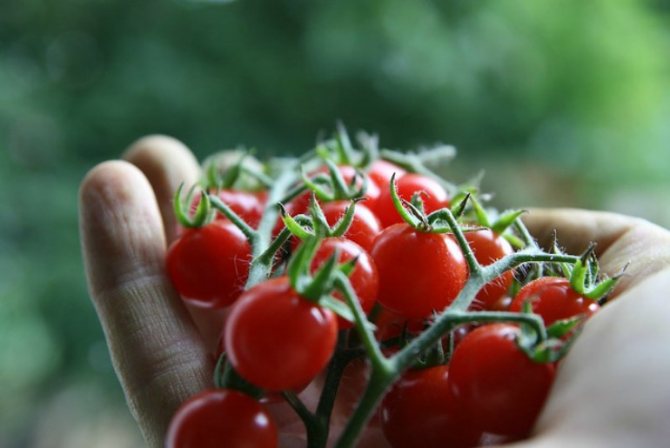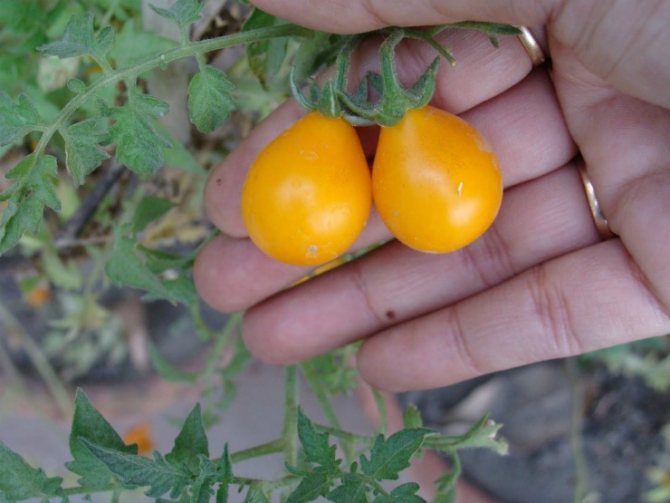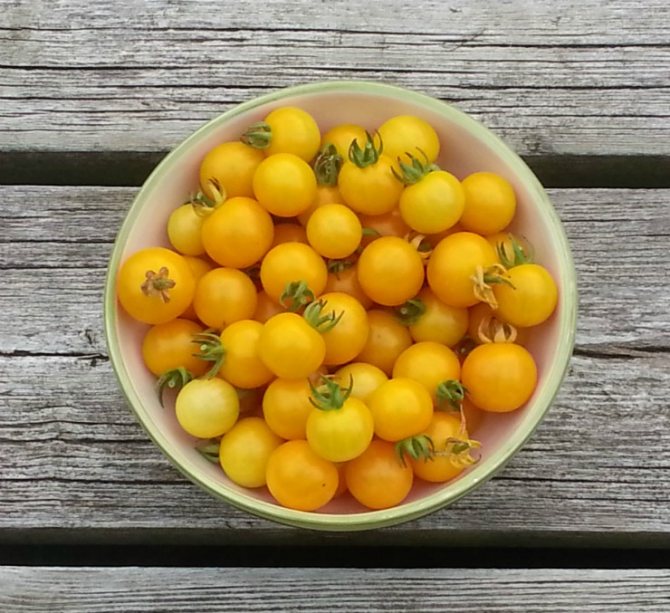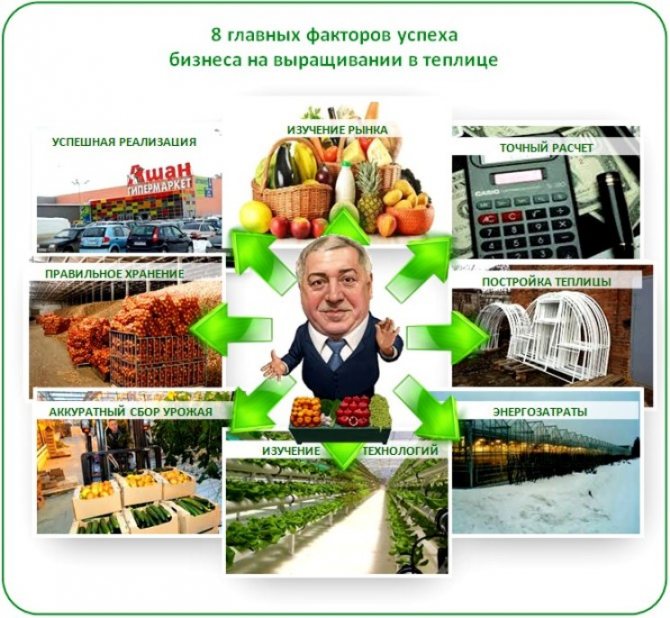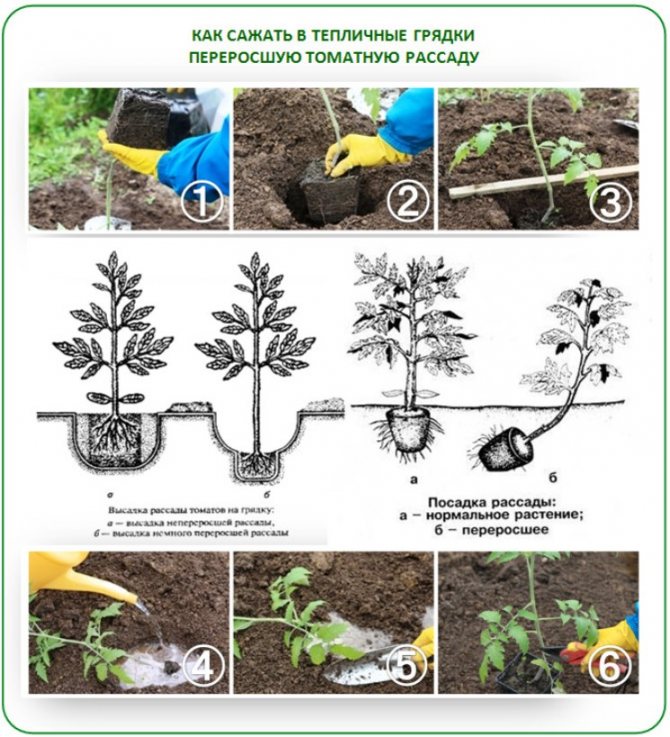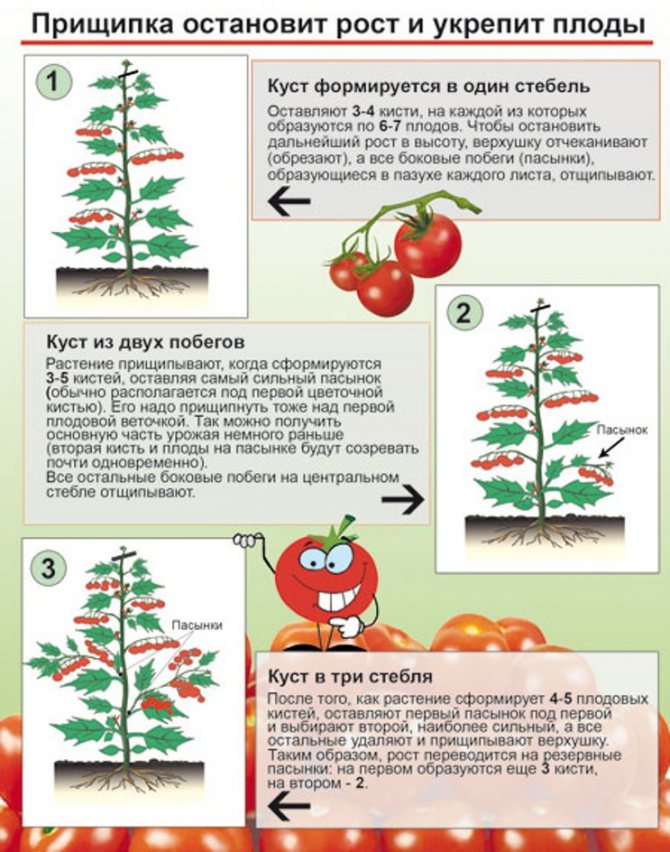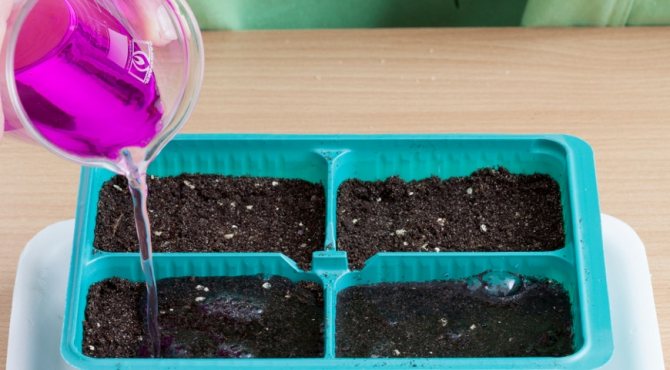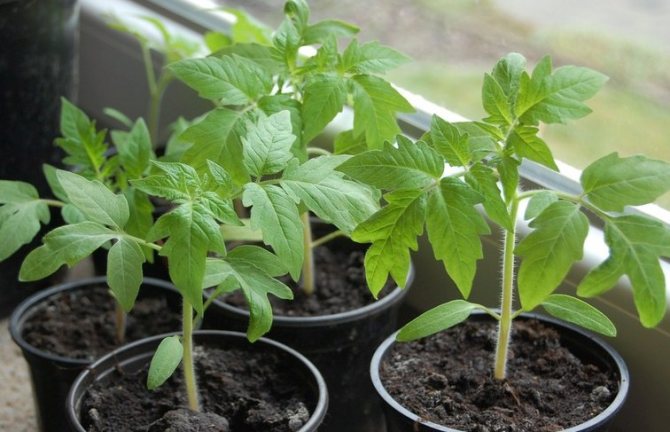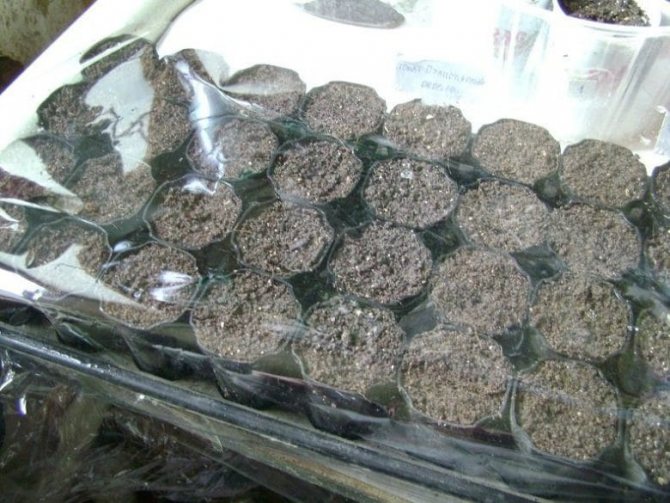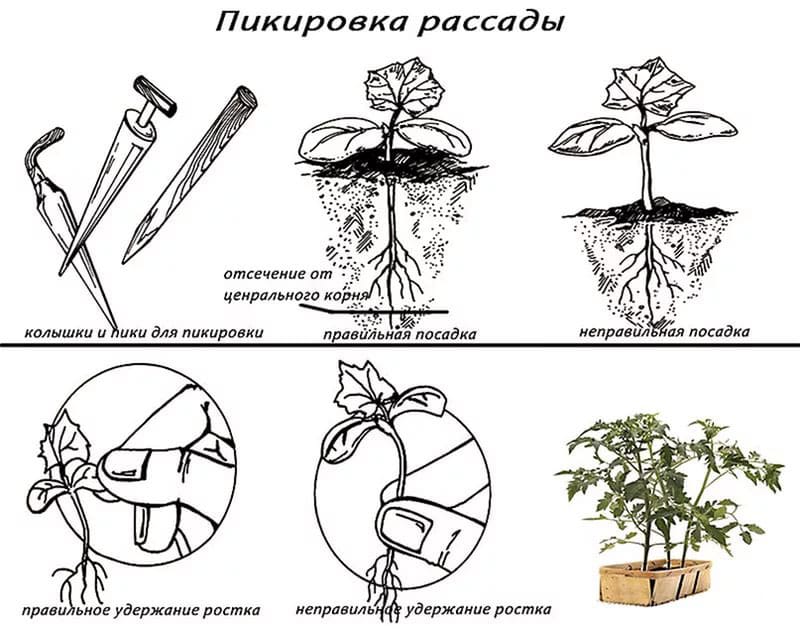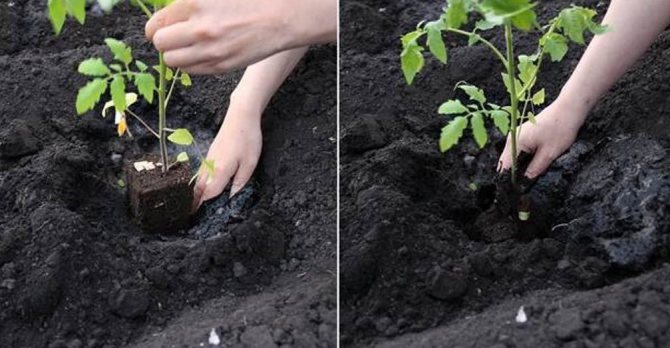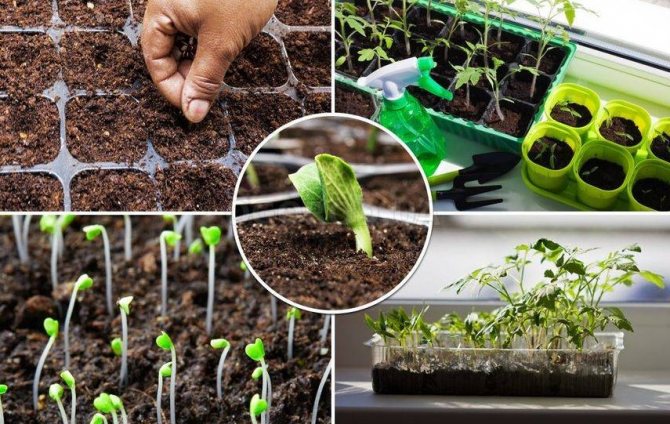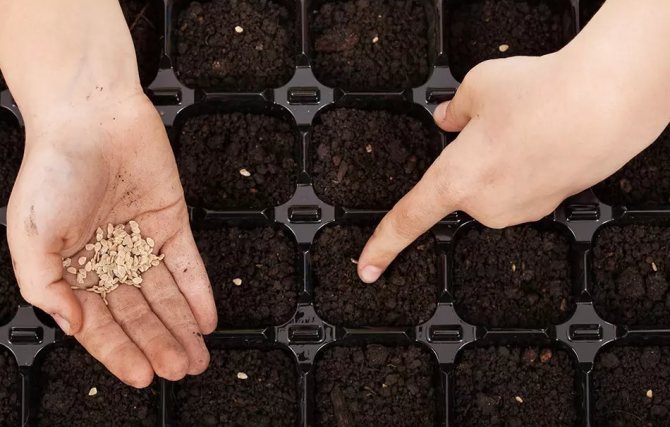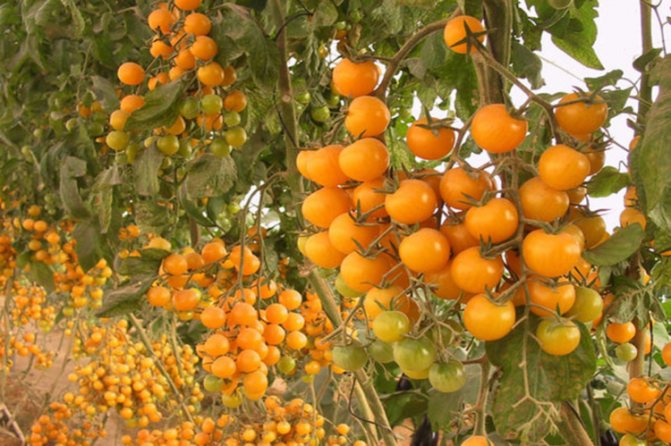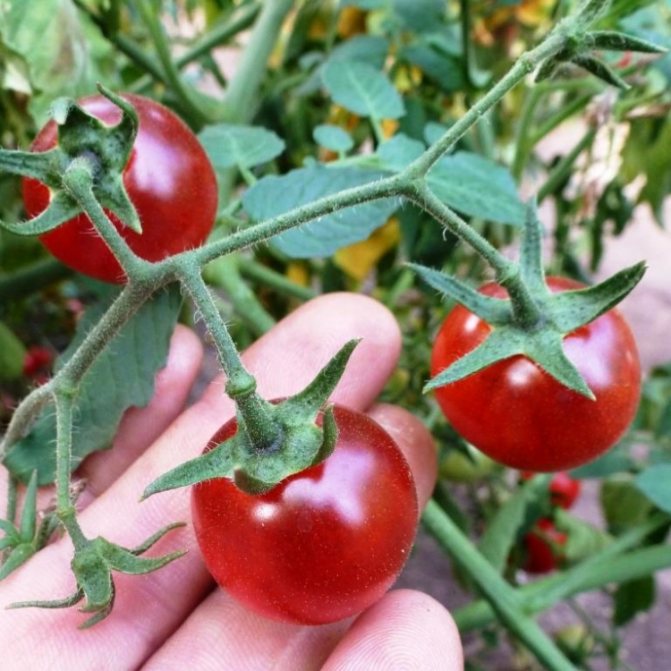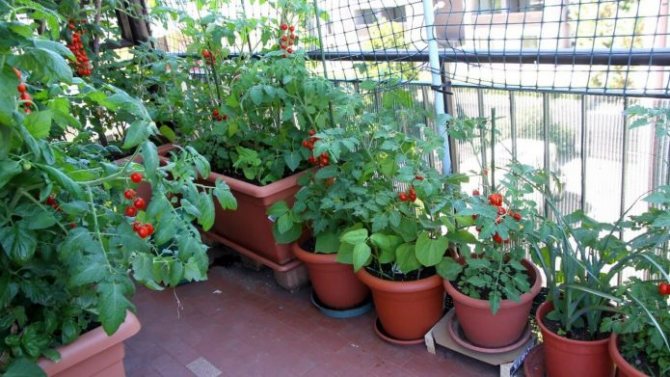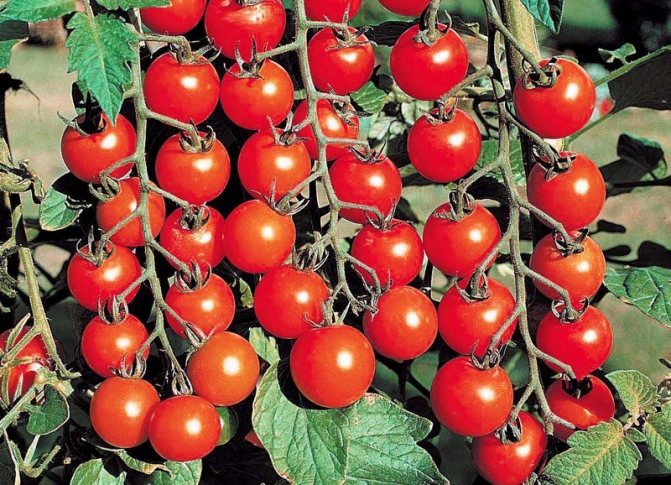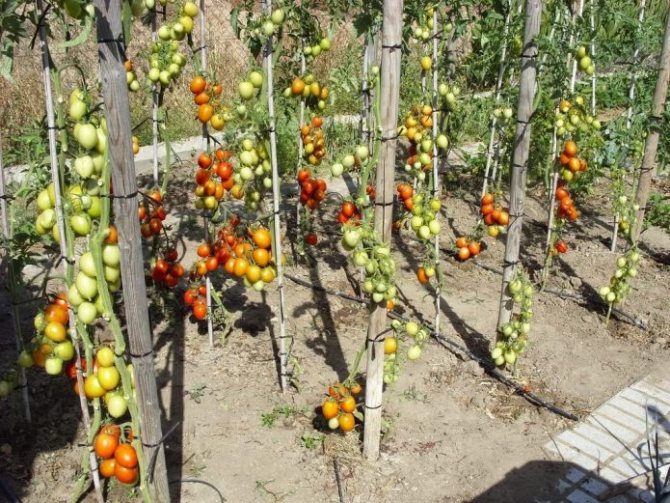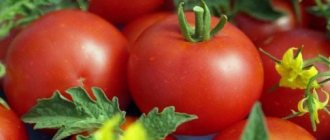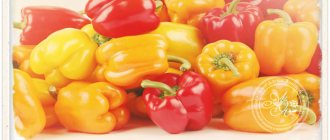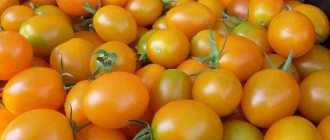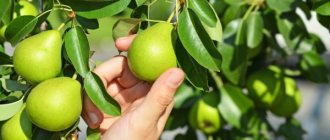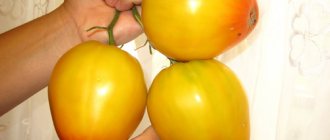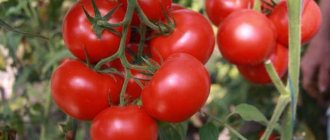Cherry tomatoes were named so for their external resemblance to cherries. For many growers, small tomato varieties are a real find. They look very nice on the table as part of salads and are great for winter pickling.
Cherry Trebus:
Cherry tomatoes are not just one variety, but a whole family of crops that share a common fruit size. Cherry tomato varieties are very different from each other. They have different ripening periods, height, fruit color, weight and shape of tomatoes.
Types and varieties of cherry
First of all, it is worth deciding on the tomato variety. This largely depends on the size of the greenhouse, as height plays an important role.
Determinant
Plants that stop growing, depending on the number of clusters tied. As a rule, growth stops at 4-5 hands, less often - 7. These include:
- Ampelny. The maximum height is 1 meter. Tomatoes are small in size, weighing about 15 g.
- Raisins F1. It is a hybrid whose fruit is in the form of cream. It differs from the previous one by earlier ripening periods, weighing up to 20 g, the number of ovaries - max. 20 and brushes - 7.
Determinant varieties are best suited for cultivation in greenhouses, as they do not require pinching and are relatively small in size, forming into a powerful bush.
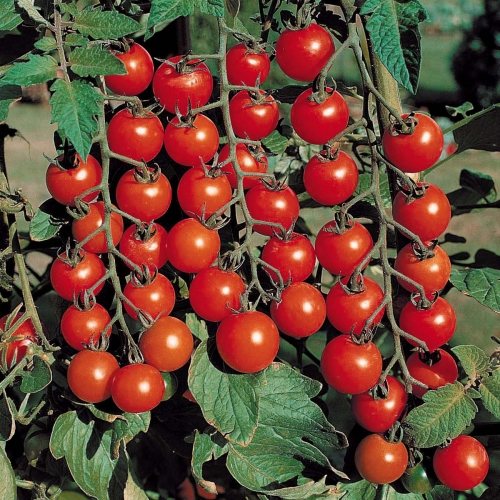
Interdeterminate
This type of tomato has almost unlimited growth, sometimes reaching 2.5-3 m. Such plants require careful pinching so that only the main stem remains, on which the brushes are formed. They are also suitable for growing outdoors, but only in warm climates. In "capital" greenhouses (heating, lighting, etc.) they can bear fruit for more than a year.
- Pear yellow F1. A mid-season variety, the height of which fluctuates on average at around 2 m. The fruits are sweet, with a berry aftertaste.
- Orange date F1. Mid-season; oval fruit with plum flavor and honey flavor. The flesh has a characteristic amber color. In a cluster up to 18 fruits with a maximum weight of 20 g.
- Black cherry F1. The name itself speaks of its color. Early ripening (65 days). The weight of the fruit ranges from 15-30 g, of which 10-12 pieces are formed per hand.
Superdeterminant
They differ from the determinant ones by their short stature and early maturity.
- Arctic. Very early variety (75-80 days). On a brush, there are often up to 22 tomatoes. Height no more than 40 cm.
- Citizen F1. Mid-season (up to 100 days from germination). The weight of these cherries is 15-25 g, which can be from 12 to 18 pieces. Ripening can be accelerated, but this requires pinching.
But that's not all. There are so-called semi-determinate tomatoes. They occupy an intermediate place between determinant and superdeterminant both in height and in terms of ripening. These types are ideal for greenhouse conditions.
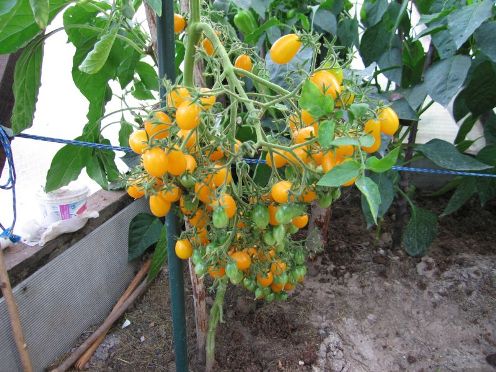

Origin story
In the middle of the 20th century, Israeli scientists were puzzled by the problem of the rapid maturation of vegetable and fruit crops. Due to the hot climate, the gardening crop ripened very quickly, which was not always beneficial to the taste of the product. Then a new kind of tomato was obtained, which was named cherry. The vegetable got its name due to its small size and shape, very reminiscent of a cherry. The weight of the cherry tomato shown in the photo is not more than 25 grams, and the bush can be tall and short.
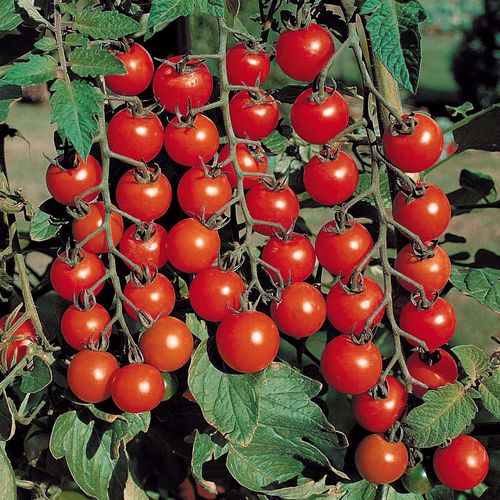

Seed preparation
Before planting on seedlings, seeds are pre-planted. You can, of course, sow dry, but then you can face: a) poor germination; b) slower growth; c) less resistance to disease. But this only applies to varietal seeds. Hybrids do not require processing.
- The first step is etching. A 1% solution of potassium permanganate is being prepared. For this, 1 g of potassium permanganate is dissolved in 100 ml of water. The color should be nearly black. The seeds should in no way be stuck together. If this is observed, then they should be well grinded to separate from each other. Then they are wrapped in a bandage, gauze, put in a bag and in this form are sent to the container for 20-45 minutes. After this procedure, the seed must be thoroughly rinsed in warm water and move on.
- Second step. The seeds are placed in a special nutrient solution without preliminary drying for 12 hours. For this, special growth stimulants for tomatoes are best suited, but most liquid ones can be dispensed with. It is important to study the instructions so as not to be mistaken in the proportions, since hardly anyone will prepare 1 liter for a handful of seeds.
- Step three. Without any rinsing, the bag is sent for a day in water, and then at the same time in the refrigerator, while it is necessary to carry out periodic spraying.
After these procedures, the seeds are ready for planting.
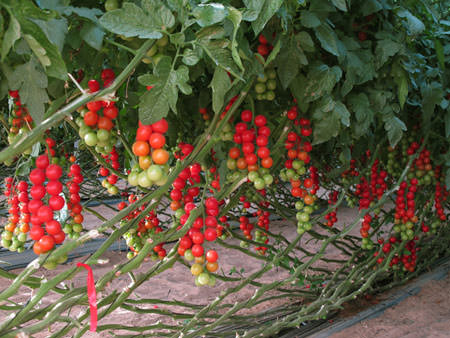

Features of agricultural technology
For cherry tomatoes, a sunlit, warm and draft-free place is preferable. Cherries grow well after:
- radishes and legumes;
- carrots and turnips;
- onions and beets;
- radish and cabbage.
Experienced gardeners will plant tomatoes in the same place after 3-4 years.
Tomato beds are prepared in the fall. The plot is dug up, humus is introduced (for 1 m2 - 4-6 buckets), potassium-phosphorus fertilizers (for 1 m2 - 20 g each). With the arrival of the spring season, the beds are loosened to a depth of 15 cm, fed with nitrogen: 10 g per 1 m2.
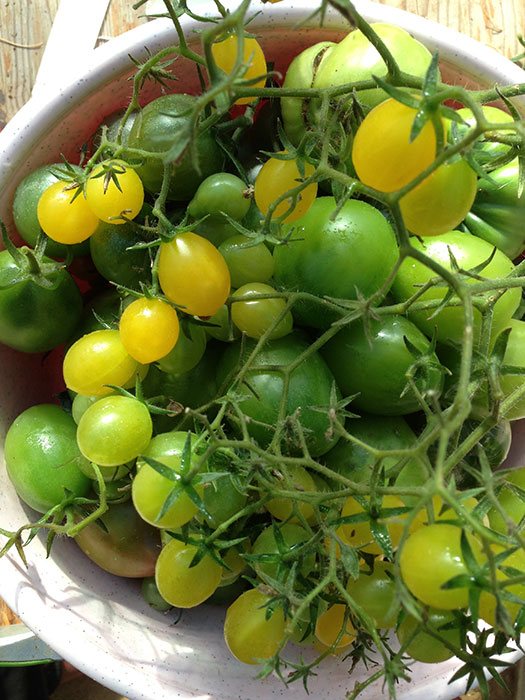

With proper care, at the time of planting, Cherry has a strong 20-30 cm stem, developed roots and 3-4 pairs of real leaves. Tomato bushes are planted in warm cloudy weather.
Tomato planting scheme:
- the interval between seedlings is 35-40 cm;
- distance in row spacing - 50-60 cm;
- hole - to the depth of the seedling cup.
The holes are watered with lukewarm water and tomato bushes are planted. Wooden pegs are placed near tall tomatoes.
Note! Cherry seedlings are transferred in the last decade of May or early summer.
Cherries can be grown outdoors, in greenhouses and greenhouses, on balconies, in flowerpots near the house, and even in flower pots on windowsills.
Cherry farming techniques are similar to "ordinary" tomatoes. In order to avoid cracking of the fruits of a number of varieties and hybrids, the moisture of the soil is monitored. Avoid abrupt changes in drying out and excessive moisture.
Indeterminate and determinant varieties and hybrids must be tied up. An exception is undersized, strong bushes of balcony tomatoes, if their fruits do not touch the soil.
Planting seedlings
The time for planting seedlings varies from February to April, although practice shows that in hot climates, you can also grow in a seedless way in greenhouses. The fruits ripen completely. It is best to take a ready-made store substrate for seedlings. It has the optimal nutrient content. If there is none, you need to cook yourself, paying attention to the type and acidity of the soil. It is advisable to ignite it in order to protect the seedlings from pests gnawing at the roots. The soil is poured into the prepared containers. Grooves are made at a distance of 6-7 cm from each other, and between the seeds - 2-2.5 cm.The depth is just over a centimeter. Then the soil is moistened and placed in a warm, well-lit place and covered with foil or glass.It is important to place the container on a stand so that the roots have access to air. When shoots appear, then a temperature of + 15-18 degrees is required for 7 days. In the future, it is raised to 20. Every day, the plants must be turned the other side to the light: this way you can avoid one-sidedness. Watering is done only twice until 2-3 true leaves appear. After their appearance, a pick is made. Weak sprouts are thrown away, and strong ones are best transplanted into peat cups, so adaptation will be better.
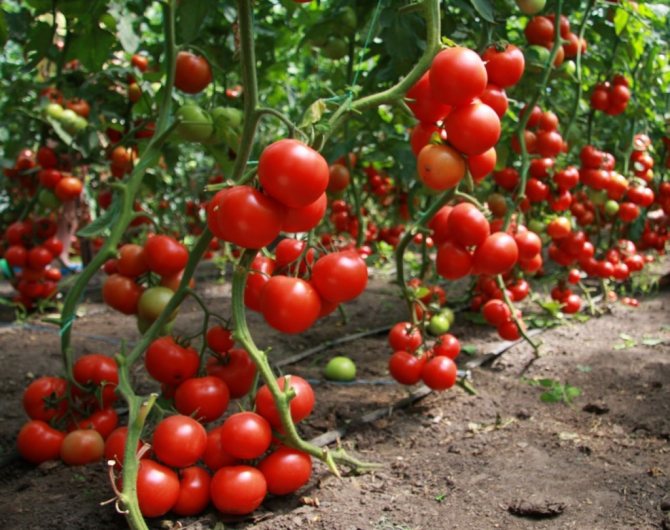

Growing cherry tomatoes: preparing the greenhouse
To plant cherry tomatoes in the spring, growers begin to prepare greenhouse shelters in the fall. The spent soil is completely removed and new soil is brought in, chemical fertilizers are introduced into it.
The drugs are used according to the manufacturer's recommendations, without exceeding the permissible dose.


Instead of chemistry, organic fertilizers can be applied:
- Humus;
- Peat;
- Sawdust.
Humus will replenish the lack of nutrients. Peat will help to keep the required moisture level in the soil and will contribute to the regulation of the temperature regime. Sawdust, when smoldering, will emit carbon dioxide, which is necessary for normal plant growth, and will protect tomatoes from root rot infection.
ATTENTION: With increased acidity of the soil, it can be fertilized with chalk or dolomite flour.
You can make your own soil, but it is much easier to purchase ready-made nutrient bases in a specialized store.
The timing of planting seedlings and sowing seeds depends on the early maturity of the species, the time the soil warms up in the greenhouse.


Greenhouse landing
An important factor in a good harvest is the location of the greenhouse itself. Tomatoes are sun-loving plants, so shading can negatively affect it. Planting ready-made seedlings depends not only on soil temperature and climatic conditions, but also on the variety and the gardener's desire to get the harvest as long as possible. Soil temperature should be at least + 15 ° С. If desired, it is measured with an ordinary household thermometer, leaving it in the soil for 20 minutes. (Measurements are best done early in the morning, as the ground is coldest at this time). During planting, the two lower leaves are removed, and the plant is deepened to this level. Watering is done not earlier than 12-14 days after planting. Planting scheme for low-growing plants: 40 cm between bushes and 45 - row spacing. For tall: 50 and 75 cm, respectively. For convenience in further processing, tomatoes are recommended to be planted in a checkerboard pattern.
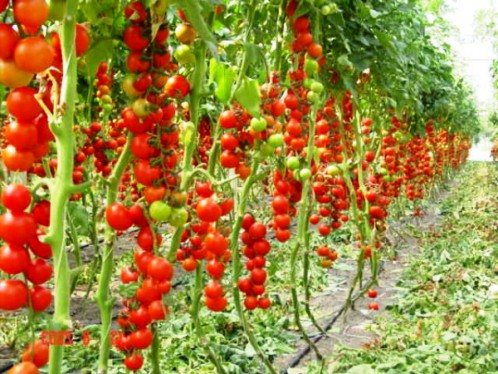

Cherry Leaves Tomatoes
It is advisable to immediately pour a warm solution of sodium humate.
Then just cover the boxes with foil and put them in a warm and bright place. Here is the full range of activities.
- During the first week after the appearance of the first shoots, you need to maintain a temperature of 15-18 degrees. In the future, the optimal mode will be 18-20 degrees. During the first 30-35 days (until 2-3 true leaves appear), the seedlings need to be watered only 2 times. This is an important condition, otherwise the seedlings will simply stretch out in March. It is necessary to turn the plants with the other side to the window every day, then they will not be threatened with one-sided stretching.
When a plant has 2-3 true leaves, it is dived into a separate pot (8 x 8 cm). In this case, all diseased and weak plants are discarded. Watering from this time is carried out once a week. After 10-12 days, the tomatoes should be transplanted into large boxes (15 by 15 cm).
There are 2 answers to the reasonable question of why diving is not carried out immediately into such containers. Firstly, each transplant inhibits the growth of the plant, preventing its early pulling. Secondly, the root system develops better in small pots, water does not stagnate in them. watering. 2 days before planting in the greenhouse, you need to cut off the first 2 (lower) true leaves. Article about the most dangerous diseases of black currant. Varieties of black currant varieties in our
Greenhouse soil preparation
It is unacceptable to plant tomatoes on the same soil where they grew last year. The same goes for eggplants, potatoes, peppers. They just suffer from the same diseases as tomatoes. Depending on the type of soil, certain additives should be added to it:
- for clay soil - 1 bucket of peat (or sawdust, humus) per 1 sq. m of surface, for peat soil - 1 bucket of humus (turf, sawdust, half a bucket of coarse sand) per 1 sq. m.
Greenhouse conditions
The greenhouse must be completely sunny. Even slight partial illumination is unacceptable. There should be sun in the greenhouse throughout the day.
Growing cherry tomatoes in a greenhouse
Tomatoes can be planted in a checkerboard pattern with a distance of 50-60 cm between plants. With a more rare or, conversely, too frequent placement, a significant decrease in yield is possible.
In this case, not overgrown tomatoes (up to 30 cm high) are planted in a specially prepared hole. If there are higher specimens, then another hole needs to be made in the hole, into which the seedlings should be planted. And after a few days, just fall asleep in the remaining recess of the earth.
During the first 10-15 days, tomatoes are not watered at all. 12 days after planting, the plants begin to tie up. In this case, the number of flower brushes should be no more than 7-8. Flowers are pollinated by lightly shaking the brushes.
It is best to do this in warm sunny weather. After pollination, you need to water the ground and spray the flowers with water. And after 2 hours, you need to reduce the humidity by airing the greenhouse.
It is necessary to be especially careful to monitor the level of humidity in the air and ground when growing tomatoes. So, if the soil is constantly waterlogged in the greenhouse, then the tomatoes will be sour, watery and not fleshy. On average, from the moment the seeds germinate and the first shoots appear until the fruits ripen, it takes about 120 days.
At the same time, the period can be reduced by 20 days with the organization of good conditions for the maintenance of plants. Cherry tomatoes are very useful for humans, they have a lot of vitamins and minerals. They are used both independently and as part of various dishes, preparations for the winter. In order not to think and not wonder whether the vegetables that everyone sees on store shelves have not been processed, you can grow tomatoes yourself. To do this, you need a greenhouse and a great desire to get a harvest!
Growing cherry tomatoes in the open field
You can grow cherry tomatoes both at home and outdoors. Their cultivation is not much different from the cultivation of conventional varieties of tomatoes.
Sowing
In order to enjoy delicious fruits, cherry seeds are sown in early spring to obtain seedlings. The soil for planting seeds should be revitalized in advance with useful substances by spilling it with an EM preparation.
In order not to bother, you can simply purchase a universal soil for planting tomatoes at a specialized store. In March, you can already sow seeds. To do this, on the open ground, grooves are made with a pencil, into which seeds are poured.
This makes it possible to sow several rows with different varieties of tomatoes, and then sign their name. The sown seeds must be sprinkled with a thin layer of soil and watered abundantly with warm water. For the successful germination of seeds, it is necessary to provide the proper conditions: a temperature regime within 25-28 degrees, as well as ten hours of daylight.
Picking
The first shoots that appear after 10 days should be placed in a cooler place. Watering the seedlings should be regular, as the soil dries out. As soon as several leaves appear on the stems, they can be planted individually in small cups.
Tomatoes are planted in the same soil as for sowing seeds. In order for new roots to appear, the stem needs to be slightly deepened into the soil. Then young plants are placed in a warm room. They can also be displayed on the balcony if the temperature is not lower than 16 degrees.
At low temperatures, it is better to leave tomatoes on the windowsill.
Hardening and planting in the ground
After the last frost has passed, tomatoes can be planted outdoors. Here you need to focus on the climatic conditions of the region.Before planting, tomatoes are hardened, periodically taken out to fresh air.
It is not recommended to water the plants the day before transplanting. The beds for planting must be prepared in advance, loosened up. Then dig holes 10 cm deep, remove the seedlings from the glass and put them in the hole, water abundantly.
After the water has been absorbed, the hole must be buried and poured again on top. The distance between tomatoes planted outdoors should be about 1 meter.
Installation of supports
Over time, when the plants reach 30 cm in height, it is necessary to build supports for them. For this, you can use trellises or metal rods. As the bush grows, it must be tied up regularly.
Regardless of the variety, cherry tomatoes need a garter.
Fruiting
Three months after planting, tomatoes give their first fruits. The branches growing from the stem can produce up to 20 small tomatoes. They all ripen at almost the same time.
Depending on the characteristics of the variety, the fruits can be harvested one at a time or plucked with a whole branch, the main thing is that they are ripe.
Transferring bushes to containers
The fruiting period of tomatoes planted in the open field lasts until the temperature begins to drop to 8 degrees. Many gardeners, with the onset of cold weather, practice planting a bush in large containers of 20 liters each, transport them to their homes and enjoy tasty and healthy for a long time. fruits. Of course, their yield will decrease slightly, but this is not so important, there will still be something to please yourself with.
Cherry tomato varieties
The most popular varieties that can be grown outdoors are:
- Beads are a very productive tall variety. It has sweet fruits with a diameter of 1 centimeter. Black cherry is considered by many to be a fruit, not a vegetable. A tall variety with black-brown aromatic tomatoes 2 cm in diameter. The honey drop has pear-shaped fruits. This species forms numerous stepchildren and clusters with 8-9 fruits. The tall cherry variety gives dark red round tomatoes. Each cluster can grow up to 20 fruits. White currants have round, creamy fruits. Up to 10 tomatoes ripen on each cluster. This variety is very tasty and is often used in various dishes and salads.
Growing cherry in greenhouses
Growing tomatoes in a greenhouse is also a good practice. It is very important that the greenhouse is heated. If this condition is not present, then the tomatoes are planted in the greenhouse already in the form of seedlings.
The distance between the planted tomatoes should be at least 70 cm. To avoid late blight, you must use a well-ventilated greenhouse. Caring for plants requires regular loosening of the soil, watering.
In the event of a lack of daylight, plants must be provided with artificial lighting. Greenhouse tomatoes, like those planted outdoors, should also be tied up. Growing cherry tomatoes in a greenhouse can be good business.
True, for this it is better to use a polycarbonate greenhouse, which is well heated and contains vents. Under such conditions, cherry tomatoes will bear fruit all winter. In terms of taste, greenhouse tomatoes are inferior to those grown in the open sun. The sun enriches them with useful trace elements and substances.
Cherry tomatoes in hanging baskets
Growing cherry tomatoes in hanging baskets is carried out using ampel varieties. When choosing a variety, it is necessary to consider:
- The selected variety should branch well and keep stepchildren out. It often happens that the branches break under the weight of the fruit. Therefore, the species chosen for planting in a flowerpot must have flexible and not fragile branches. Be sure to choose varieties that produce small fruits.
Cherry tomatoes grown in hanging baskets on the balcony should be sown in early May. In case of cold weather, it is better to bring the plants into the house and put them on the windowsill. The bush will not branch for a long time.
This state will be before the beginning of the appearance of fruits. Under the weight of numerous berries, the branches will bend to the bottom and thus create an extraordinary decorative effect on the balcony or windowsill.
To share with friends:
These small tomatoes got their name from the English word "cherry", which means "cherry". The name was attached to them due to the fact that their appearance is very similar to this berry. The best for growing this crop is black soil, to which a little sand is added.
In terms of acidity, the soil should be neutral or slightly acidic. Recently, cherry tomatoes have become more and more popular. They go well with many products and can perfectly complement almost any dish, not only as an ingredient, but also as a decoration.In the variety of choices of Cherry tomatoes there are both different in color (red, yellow, raspberry, green, orange) and in shape ( round, oval) varieties. Unlike ordinary tomatoes, cherry flavor is more pronounced.
They are sweeter, contain antioxidants, and are high in vitamins. And, of course, children like them much more. And the opportunity to grow them not only in the greenhouse, but also on your windowsill made them the favorites of both summer residents and city dwellers.
Caring for them is easy. Most of the varieties are early maturing and tall. Their height is more than a meter. About 20 fruits ripen on one bunch. There are also undersized tomatoes of this variety.
The average height is 30-40 cm (Bonsai), but there is also lower (Mikron-NK). The smallest fruits weigh no more than 10 g. The largest weight does not exceed 30 g.
Growing Cherry Tomatoes
Saltpeter, for example, helps to increase the mass of fruits, and on the other hand, delays their ripening.
- planting seedlings in open ground;
For our climate, this is the best option. There is no point in sowing seeds directly into the open ground, since the weather is warm enough for this only at the very end of May. And this is too late for all the tomatoes to bear fruit.
And caring for them will be more time consuming. At night, it will be necessary to additionally cover the crops with a special film so that they do not freeze. It is better to sow seeds for seedlings from mid-March to mid-April. So, take a suitable form and pour the soil into it.
It can be bought ready-made in the store.Make grooves, spill them with warm water, sow seeds, sprinkle on top with soil, no more than 4 mm high, and pour with warm water. The key to a good harvest is good sowing care. Pay attention to the quality of the seeds.
Throw out empty seeds immediately. It is better to place the forms on the windowsill. Tomato seeds love the sun. Seedlings should appear in about 5 days. From time to time, seedlings need to be watered. Tomatoes love moisture, but you don't need to pour them either.
Sometimes it is worth loosening the soil so that the roots of the plant receive more oxygen. When 3-5 leaves appear on the seedlings, it will need to be planted in separate cups.
It is better to take containers from 200 ml and use the same soil. Plant the stem and roots of the plant a little deeper so that they can form new roots. If the balcony is more than 15 degrees, you can take them there. If less, then back to the windowsill.
Plant care remains the same: daily watering and sometimes loosening the soil. The best place for plants is sunny. It provides conditions for the proper development of the tomato. Cherry does not need to be pinned.
But if you notice that the bushes have become too branchy, you can safely cut off unnecessary branches.What are stepchildren? These are the very leaves that grow between the trunk and the main leaves of the plant.
Do not confuse with the main ones! It is possible to plant seedlings in the ground only after the threat of frost has been excluded. Cherry tomatoes should be seasoned before planting.
7-10 days before planting, take out the seedlings for a day on an open balcony or street. The day before transplanting, you need to stop watering the plants. Prepare the bed in advance, remove all weeds from it and loosen it. The depth of the holes is about 10 cm.
We take the seedlings from the glass and put them in the hole together with the earth, pour them with water and then sprinkle them with earth. From above it needs to be watered a little more. The distance between the tomatoes is approximately 1 m. A support will need to be placed next to each plant.
It can be either a metal rod or a wooden one. Hazel branches are perfect. As the tomatoes grow, they need to be tied to this support. After 2.5-3 months, the bushes begin to bear fruit. You can collect the fruits either individually or with branches.
Outdoors, cherry tomatoes will bear fruit until the outside temperature drops below 8 degrees.
- planting seedlings in a greenhouse;
It is better to plant cherry tomato seedlings in an unheated greenhouse not earlier than at the beginning of April. The distance between the tomatoes is about 50 cm. You need to grow them in the greenhouse in the same way as in the open field.
Care also consists in daily airing so that no microorganisms grow on the tomato leaves. You can grow tomatoes in a heated greenhouse all year round.
- planting seedlings in an apartment;
In order to grow Cherry tomatoes in an apartment, you need to give preference to low-growing varieties, such as, for example, the Micron-NK tomato, Bonsai. Seedlings are sown in the same way as for open ground or greenhouses. Then it is transplanted into pots with a volume of at least 5 liters.
- planting tomatoes in hanging baskets;
The best option for growing Cherry tomatoes in hanging baskets is varieties with a height of 50-100 cm. At first, the bush will stand upright. As soon as fruit ovaries begin to appear abundantly, it will go down and its flowing branches will become a wonderful decoration for your balcony.
Cherry tomato care: features
Cherry tomatoes do not tolerate drought. The fruits begin to crack immediately. Water the plants every day. But you can't pour them either. Due to excess moisture, the tomato bush may simply begin to rot.
The distance between the tomatoes should be rather big, since the plant is very light and air-loving. Tomatoes must be tied up, or they will simply fall to the ground under the weight of the fruit and break. The beds for tomatoes should be 15-20 cm above ground level. You need to harvest when the tomatoes turn red and fully ripe.
Then they will be sweeter and more delicious. For some, agricultural technology helps to achieve this. Absolutely all tomatoes, including Cherry, are afraid of fogs.
They turn black and become unusable, in which case you can even pick a green tomato and put it in a cardboard box. Transfer each layer with a newspaper. Put in a dark place to ripen.
But this is quite an extreme case. In order for the tomato to preserve all the nutrients and nutrients in the required volume, it must ripen on a branch.
Variety of varieties of cherry tomatoes
One of the most important rules for a good harvest of Cherry tomatoes is to choose the variety that will suit your growing conditions. The second rule is to grow each tomato in accordance with its requirements.
All Cherry tomatoes can be divided into three groups according to the height of their bush: Determinant tomatoes are low-growing varieties that are well suited for growing at home: Bonsai, Micron.For growing on the balcony, varieties such as the Minibel tomato, Balconnoe miracle, Bonsai, Cherry Likopa are well suited. The indeterminate tomato can reach a height of 2 m. More often these are liana-like varieties of tomatoes.
Such a tomato can be successfully grown in the open field and in a large greenhouse. For open ground, such varieties as White currant, Busiki are optimal.
For hanging baskets, the varieties Garden Pearl, Citizens, Cherripals are suitable. The semi-determinant tomato is something between the first and second varieties. All varieties of Cherry tomatoes are early ripening. Low-growing varieties, such as the Bonsai tomato, also belong to the early ripening varieties of tomatoes.
What are the beneficial properties of cherry tomatoes?
We can talk about the beneficial properties of these small tomatoes for a very long time. The main ones include the following: they contain many minerals, they help in the work of the lymphatic, hematopoietic systems; improve metabolism; very rich in vitamins, especially B, C, E, antioxidants, amino acids, lycopene.
The only limitation in eating them is stomach ulcers. Cherry tomatoes justifiably occupy one of the leading places not only in countries with a southern climate, but also in our country. They are unpretentious, early maturing, they are easy enough to grow. These tomatoes are healthy and, of course, delicious.
Tomato care
Cherry tomatoes for growing in a greenhouse do not require much hassle. Caring for them includes a standard "set": watering, loosening, and for interdominant varieties, also pinching. Watering is necessary regularly, but not plentiful. A lack of moisture leads to cracking of the fruit, and an excess affects the wateriness and taste. Loosening improves air access to the roots and prevents them from rotting. Like ground tomatoes, growing in a greenhouse is very sensitive to "rain" watering from a hose. Moreover, if it comes from a centralized water supply or a well. Cold water and high air temperatures have a detrimental effect on bushes. The best option is to water at the root with warm water, for example, from a barrel, which is desirable to put directly into the greenhouse. Unlike other types of tomatoes, cherry tomatoes must be tied up regardless of their size. This does not apply only to ampel varieties that are grown in suspension.
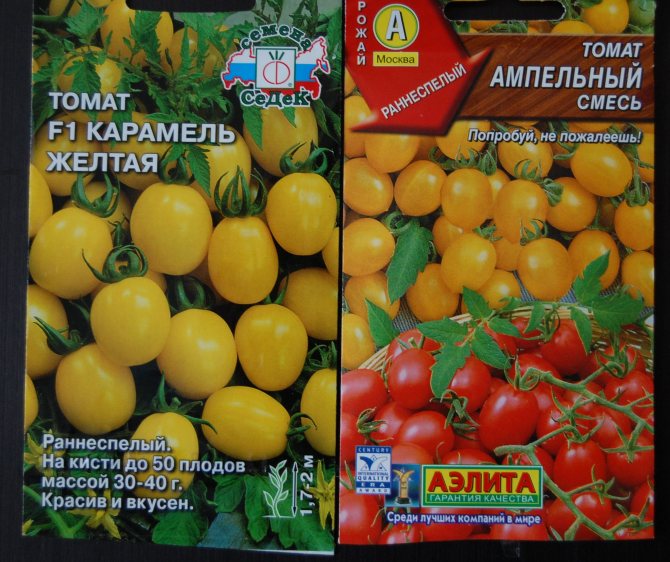

If in open areas the process of pollination is carried out "naturally", then in a greenhouse it is a man's business. There is nothing complicated: the brushes are slightly shaken. From this, the pollen falls on other flowers. It should be borne in mind that the temperature should not be higher than +35 degrees and not lower than +12, the humidity should not be higher than 65%, and watering after this operation should be done not earlier than 2 hours later. The pollination procedure is carried out 2 times a week. Cherries are fed in the same way as simple tomatoes. It is difficult to do without chemistry, but manure was and is the best fertilizer. The solution is prepared as follows: manure is poured into the selected container and poured with water in a ratio of 1:10, mixed and left to ripen for 2-3 days, although the minimum is 1 day. Then 1 liter is diluted in a bucket of water and one liter is poured under the root.
Plant feeding
Plant feeding is done once every two weeks, for this they use:
- Infusion of herbs;
- Chicken droppings solution;
- Lake silt;
- Infusion of wood ash.
Crushed garlic can be added to any of the nutrient solutions.
If you don't have organic fertilizers at hand, you can take ready-made fertilizers produced in a factory way. Chemical fertilization is stopped when ovaries begin to form on the plants.
Diseases of cherry tomatoes
Although these tomatoes are disease resistant, some varieties can develop fungi and rot.There may be late blight, bacteriosis, black leg, mosaic, root and apical rot, cracking of fruits and others. Therefore, preventive and therapeutic measures are carried out as for ordinary tomatoes.
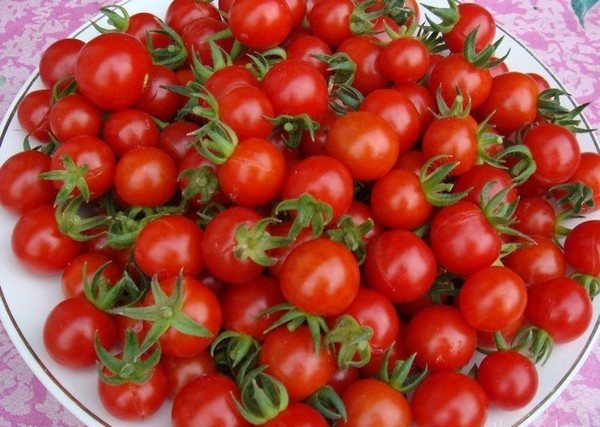

Growing cherry blossoms in a greenhouse will not be difficult. The main thing is to adhere to agricultural technology, and then harvesting will bring complete satisfaction.
More about varieties
Scientists have bred several types of tomatoes of the same variety. So, cherry Businka is a tall, early ripening plant with high yields. Variety Marishka refers to early plants, tall with raspberry-colored tomatoes. Mariska grows well in greenhouses.
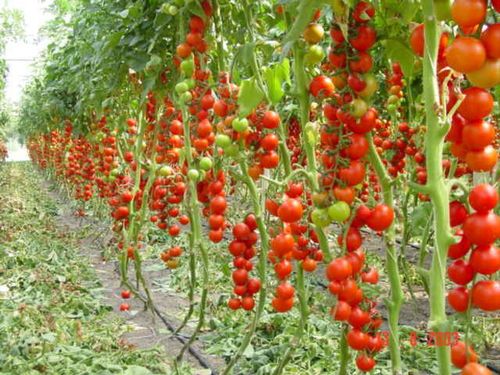

The early varieties of scarlet and yellow cherries include all varieties of small tomatoes that bear fruit well in greenhouses. On open soil, cherry Scarlet and Golden cherry, form up to 45 fruits on one bush. The varieties of small tomatoes Kira and Zolotaya Bead stand out for their excellent taste. They can be grown both in the open field and in greenhouse structures.
The following varieties are suitable for breeding in greenhouses:
- Minibel.
- Bonsai.
- Little Red Riding Hood.
All of the aforementioned tomato varieties grow well in greenhouse conditions. They are distinguished by fast ripening, excellent taste, unpretentiousness.
Harvesting
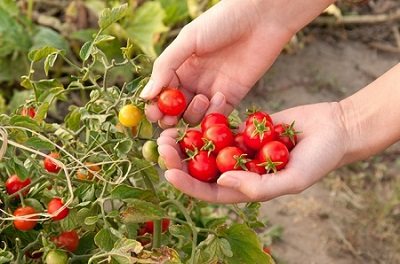

Each variety of cherry tomatoes has a different ripening period, but most begin to bear fruit after three months after planting in the ground. You can harvest a good harvest until the end of September, and some varieties are full until the air temperature drops to plus seven degrees.
The indisputable advantage of the Cherry tomato is that they almost all begin to sing at the same time. It is best to pluck the tomato brushes when all the fruits are ripe.
Since tomatoes bear fruit until the very cold weather, do not forget that with the arrival of cold weather fogs appear, and their tomatoes are very disliked. If he nevertheless fell into the fog, then it is better to pick them unripe and place them in boxes for ripening, otherwise they will subsequently begin to taste bitter and simply rot.
When the cold comes, many gardeners want to prolong the enjoyment of the cherry tomato harvest, so they dig them out of the ground, plant them in large buckets or pots, bring them into a warm place, and enjoy fresh cherry tomatoes for a long time.
From the resulting harvest, you can get seeds for the next planting. For this, well-ripened fruits are collected from the lower brushes, seeds are collected from them in a small container, placed in a warm, dark place for fermentation to occur. After that, they are washed with water and put to dry. Then they are removed for storage.
In the past, cherry tomatoes were undoubtedly a curiosity and rarity. Now, without much difficulty, such a "rarity" can be grown at home, you just need to adhere to the basic rules of growing these tomatoes.
Phyto-diseases and pests
Most cherry varieties and hybrids are resistant to rot and fungal infections. The main scourge is late blight. Disease prevention begins immediately after planting seedlings in a permanent place.
Plants are treated with fungicides every 10-15 days, spraying is stopped about a month before harvesting. Further, the fight against late blight is carried out mechanically - the affected leaves are cut off by hand.
Many cherry varieties are not afraid of the rotting process and fungal infections. The main threat to plants is late blight.
To avoid infection, prevention is carried out immediately after the plants have been planted in a permanent place. The bushes should be treated with fungicides every two weeks.
Despite the care and immunity to fungal infections and rot, cherry tomato plantings are exposed to phytophthora. The plantings are sprayed every 2 weeks. Stop processing the bushes a month before harvesting the fruit.
They are processed with Bordeaux mixture, which is prepared from:
- water - 10 l;
- freshly slaked lime - 100 g;
- copper sulfate - 100 g.
Note! Symptoms of tomato mosaic are a change in the shade of the foliage, the formation of dark green or yellowish specks. The foliage is characterized by wrinkling and twisting, for the fruits - yellowness and drying out. Removal and burning of diseased plants will be required.
Manifestations of brown spotting of tomatoes include the formation of spots on the bottom of the leaves. Brown color and gray bloom signal the disease. In order to prevent illness, vegetable tomato waste is carefully removed.
Cherry tomatoes are often affected by harmful insects:
- Medvedka. The parasite makes moves deep in the ground, gnaws at the base of the tomato stem, causing wilting and death. Thunder is used for processing.
- Wireworm. It injures the root system, gets inside the tomato stem. As a result, the tomato dies. They fight the wireworm by digging the soil, collecting and destroying the larvae. With increased acidity, the earth is lime.
- Colorado potato beetle. Produces egg-laying on the underside of the leaf. The larvae eat the foliage up to the trunk. Pests are collected by hand and destroyed. Prestige is a processing chemical.
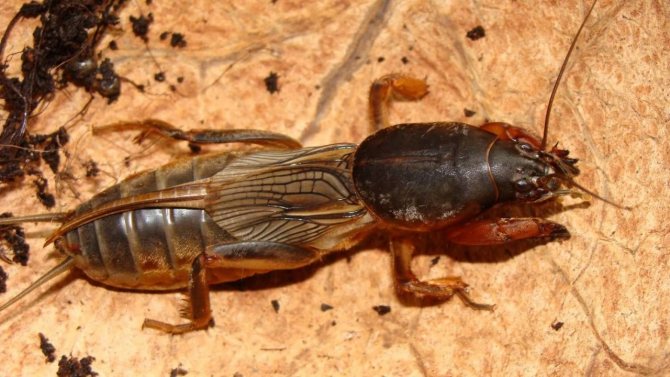

Medvedka

